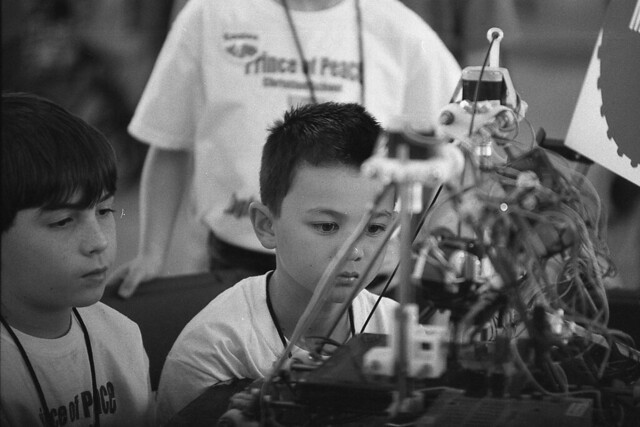.jpg) |
| Aluminum Bed Heated w/ Resistors |
Why such a large plate? I'm making the machine for someone else, and they insist on making the printer huge. Print beds are usually a quarter of this size. I've had large prints on my smaller ~1'x1' printer warp/peel up even though they're on the heated bed, so I'm not sure if using the entire bed will be practical.
Why use aluminum? It's light, flat, and cost isn't a big issue for this project. It does act like a big heat sink though, so someday I would also like to try using just glass.
27 30 Ohm resistors wouldn't get the massive aluminum plate hot enough for PLA (60C) at 12V. So, I ended up getting a 15V power supply to get the heat to max out at only 65 degrees C. It was using 10.8 Amps at 12V with 27 resistors. Unfortunately, RepRap's RAMPS electronics can only handle 11A without blowing a fuse, so I wired the resistors directly to the new 15V power supply. It's doesn't need to be controlled by the RepRap's electronics because it consistently stays near the required 60 degrees C for PLA.
Here's info about the aluminum clad resistors I used (from Mouser):
71-RH10-30
RH01030R00FC02
10watts 30ohms 1%
Price: $2.83
Link: http://www.mouser.com/ProductDetail/Vishay/RH01030R00FC02/?qs=N4jMYmtGExdh5bRWPNF0Fg%3d%3d
Some things I learned:
27 30 Ohm resistors wouldn't get the massive aluminum plate hot enough for PLA (60C) at 12V. So, I ended up getting a 15V power supply to get the heat to max out at only 65 degrees C. It was using 10.8 Amps at 12V with 27 resistors. Unfortunately, RepRap's RAMPS electronics can only handle 11A without blowing a fuse, so I wired the resistors directly to the new 15V power supply. It's doesn't need to be controlled by the RepRap's electronics because it consistently stays near the required 60 degrees C for PLA.
Here's info about the aluminum clad resistors I used (from Mouser):
71-RH10-30
RH01030R00FC02
10watts 30ohms 1%
Price: $2.83
Link: http://www.mouser.com/ProductDetail/Vishay/RH01030R00FC02/?qs=N4jMYmtGExdh5bRWPNF0Fg%3d%3d
Some things I learned:
- It is going to take a lot more resistors/voltage/amps to heat such a large aluminum plate to 110 degrees C for ABS plastic. This setup should definitely work for a smaller ~12"x12" aluminum plate.
- This definitely won't work if the resistors are in series, pay attention to how it's wired in the picture. (There's a wire going to one side of all the resistors, and another wire going to the other side of all the resistors.)
- Amps per resistor go down as each resistor is added to the parallel circuit. More voltage makes the amperage through each resistor increase (Ohm's Law) and the heat will increase as the amperage through each resistor increases. The formula for resistance is (figure out the rest with Ohm's Law):
Rtotal = (R1−1 + R2−1 + …Rn−1)−1 - Increasing the voltage past 12V was necessary, so a variable voltage power supply that can handle a large number of Amps would help here. I see them on Craigslist pretty consistently.
- Adding insulation to the back really helped get it to heat past 60C (I just superglued cardboard over the resistors, maybe some kind of foam or wool would be better.)
- JB Weld worked to glue the resistors to the plate, but some kind of thermal epoxy might have been better. Making a pool of JB weld, dipping the resistor, then putting it on the plate is the best way to do it.
- Since the goal is generating heat, the resistors can be run over their watt rating.
- 16 gauge "Heater Wire" from Ace Hardware works, but the Reprap IRC mentioned some type copper hardware to connect resistors like this more efficiently.
- Using AC voltage may not be a bad idea, but it will require extra grounding and more danger. I attempted to use an AC to 18V DC transformer that plugged into the wall, but it couldn't handle all the current.
- The resistance of the wire didn't seem to be enough to make a difference. I was worried about wiring all the resistors on the same path, because I thought less electricity would go through the last resistor.














